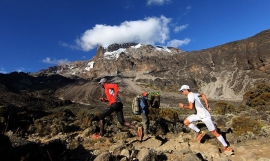Editorial Reviews
Review
""McGill's text on "Low Back Disorders" is one that every treating clinician should have for their own professional library.""-"AAESS News "(Australian Association for Exercise and Sports Science) ""This is a fine blend between science and practical application by a credible author. The author is in a unique position to share his own valuable research and clinical experience to advance the treatment of alleviating low back disorders." "Doody's Book Review Service
Review
"McGill's text on Low Back Disorders is one that every treating clinician should have for their own professional library."
-AAESS News (Australian Association for Exercise and Sports Science)
"This is a fine blend between science and practical application by a credible author. The author is in a unique position to share his own valuable research and clinical experience to advance the treatment of alleviating low back disorders."
–Doody's Book Review Service
"McGill has created an outstanding scientific work on the prevention and rehabilitation of low back disorders."
–CHOICE
About the Author
Stuart McGill, PhD, is a professor at the University of Waterloo at Waterloo, Ontario, Canada, and a world-renowned lecturer and expert in spine function, injury prevention, and rehabilitation.
McGill has written more than 200 scientific publications on the topics of lumbar function, low back injury mechanisms, investigation of tissue loading during rehabilitation programs, and the formulation of work-related injury avoidance strategies. He has received several awards for his work, including the Volvo Bioengineering Award for Low Back Pain Research from Sweden.
McGill has been an invited lecturer at many universities and delivered more than 200 addresses to societies around the world. As a consultant, he has provided expertise on assessment and reduction of the risk of low back injury to government agencies, corporations, professional athletes and teams, and legal firms. He is one of the few scientists who consults and to whom patients are regularly referred.
Customer Reviews
This is a vital book concerning one of the major problems of our modern life.
Prof. Stuart McGill is a professor in the Dep't of Kinesiology at the University of Waterloo, Ontario. He is the director of its Spine Biomechanics Laboratory.
This is his famous textbook, "Low Back Disorders", which examines back injuries in the light of biomechanics' scientific knowledge, and prescribes exercises and tests for the rehabilitation of injured backs and the prevention of future injuries.
The book has 241 pages of solid, dense text and extremely valuable information, with a great number of pictures and tables. And it comes in a superb hard cover. You get full value for the money.
"Low Back Disorders" is primarily geared to professionals in back treatment and rehabilitation, who want to become more sophisticated practitioners and learn the scientific facts underlying rehab techniques.
But, in the same light, this book is also essential for any member of the 3F club (Physical Fitness Fanatics) concerned about the impact on the back of fitness training and athletic practices.
Saving one's back from injury is vital, the more so that most physical fitness fanatics are urban professionals who tend to spend a large portion of their lives sitting, not a natural posture for the architecture of the back, and as they grow older, when the back becomes more fragile and vulnerable.
Stuart McGill assumes that most readers are not familiar with the full scientific facts of back architecture and function. So, he starts with the very basics and gives us a primer on "Essentials of the Back 101".
Central to Stuart McGill's tenets is insisting on the importance of
- maintaining the "neutral posture" of the spine,
- respecting the natural lower-back curvature,
- and not imposing extra flexion to the natural curvature of the upper spine.
This leads to the debunking of traditional training exercises, such as the classic sit-ups and all varieties of crunches, which create extreme flexion and high levels of compression in the spine, and undermine back stability.
He insists on
- tensing all the abdominal muscles in an isometric bracing of the abdominal girdle as the fundamental principle of providing stability and protection to the back,
- and using a stable torso solidly linked to the pelvis as a relay of force generated by the hips and shoulders, and not by the back.
In the same vein, the good professor warns against the use of most machines offered in commercial gyms, such as the Roman chair, back twisting machines, leg press-up machines.
He objects to
- the permanent sitting required for these machines,
- and the fact that they limit joint motion to a strict mechanical pattern, depriving all the soft passive tissues of their natural range.
He deplores the perversion introduced by bodybuilding in the current trends of physical training. Very strong men have only hypertrophied muscles, and no overall fitness. Just pull sideways on his sleeve, and the strongman may well lose his balance.
Prof. Stuart McGill's famous motto is "Groove the motion, train the movement, not the muscle".
Prof. Stuart McGill is famous for his preferred "BIG THREE" exercises for the back:
1) the curl-up,
2) the side bridge,
and 3) the birddog,
all of them with stages of increasing challenge and complexity.
There are quite a few more, if not so basic as the "Big Three", all detailed throughout the book, with an abundance of good pictures.
For warm-up of the spine, nothing better than the cat/camel exercice.
Stuart McGill shows how to achieve back stability and spare the low back by
- maximizing the fundamental use of hips (the "hip hinge")
- and recruiting the use of the powerful gluteal muscles (with the clam and one-leg squats).
In general, he recommends:
- use of free weights, dumbbells, cables, stretch bands and resistance tubes,
- preferring one-armed and one-leg exercises as being more challenging than symmetrical exercises,
- avoiding the extreme end range of motion in exercises.
- avoiding being seduced by a misguided conception of "flexibility" for the back,
- being wary of the overuse of "stretching" exercises for their only sake.
- and being very skeptical of many practices of the fashionable vogues, such as yoga, or Pilates.
He insists on
- learning correct motions,
- grooving them to obtain perfect form,
- and only then cultivate ENDURANCE by a SERIES OF SHORT SETS, instead of increasing the number of reps in one long set. Endurance comes before strength, which is developed only once endurance is established.
Only Ch. 13, the last one, analyzes "Advanced Exercises", those for high-performance workers and athletes, putting the accent on low-back exercises to be practiced only by athletes who already have established a solid base of fitness and overall strength.
He wisely warns that Olympic lifting is an expert specialty that should be left to the professionals in this sport. He bemoans the fact that many young lifters, even though aware of his warnings, still manage to damage their backs.
He insists that regular 3F members, ordinary urban physical fitness fanatics, should be very cautious in trying to imitate too eagerly the training programs of professional competitors before they have established enough advanced fitness and strength.
Top professional competitors are not in sports and athletic pursuits for fitness, or good looks, or losing weight, but they enter an arena as modern Samurai or heroic warriors engaged in intense fights where the only goal is pulverizing an opponent and "winning," as a step to gaining fame and riches. In this world of extreme competition, "back fitness" is a secondary consideration, and "back injuries" a professional hazard that's par for the game.
This last chapter is revisited and vastly amplified in Prof. Stuart McGill's other book, "Ultimate Back Fitness AND Performance", especially geared to performers in sports and athletic competitions. This fitness manual is indeed another essential book for any member of the 3F club (Physical Fitness Fanatics) concerned about his/her back.
ALERT: TRY TO GET THE 4TH EDITION OF THE "ULTIMATE BACK FITNESS AND PERFORMANCE", INSTEAD OF THE 3D EDITION, AND DON'T GET CONFUSED BY AMAZING AMAZON'S LISTINGS
Warning! You will find this ULTIMATE BACK FITNESS AND PERFORMANCE book listed on Amazon in two different sections:
1) in the BOOKS section under its original title, which clearly figures in caps on the cover, indicating also in caps, FOURTH EDITION. However, when you examine the details of the book, you read that what is offered is the 3d edition of 2004 (in spite of the cover picture).
2) in the ALL DEPARTMENTS section, the offering is the 4th edition of 2009, but it now is given a slightly different title, with "&" replacing the original "AND". The cover picture remains that of the original cover with its original title, figuring "AND".
So when you search for the book with its original title, you are automatically referred to the listing in the BOOKS section offering the 3d edition. You will never guess that there is also a listing for the 4th edition, since, to find it, you have to know that you have to change the title by replacing "AND" with "&". Even I was not aware of this manipulation.
So the same book is listed in two different sections, offering either the 3d edition (2004), or the 4th edition (2009) of the same book, under SLIGHTLY DIFFERENT TITLES. You have to admire marketing ingenuity, or the art of deceiving the consumer.
This kind of game seems to be pretty unusual, and a tricky marketing gimmick, to keep selling the copies of the 3d edition still available.
However, don't be so sure. For I wonder whether Amazon is not using this trick for other books, or other products, creating new listings in ALL DEPARTMENTS different from their original listings in their respective natural sections, but still offering the same product in slightly different formats. Think of the ethics of the practice, and question whether this does not smack of fudging.
You can also get two DVDs produced by Stuart McGill, which are also helpful, as live illustrations of the two books. They offer good content, but are not professionally polished.
The great value of "Low Back Disorders" is that it is based on a scientific understanding of the basic facts in the anatomy, physiology, and biomechanics of the back.
In spite of some readers' objections, I feel it is extremely valuable to exactly understand how the back works -- basic facts about which most people have not the faintest idea --, and Prof. Stuart McGill does a first-class job in giving us the fundamentals.
- We discover our neglected extension muscles, "Longissimus," "Iliocostalis," and "Multifidus".
- We regain acquaintance with our familiar "Rectus Abdominis", which happens to be one and not a family of six.
- We get a full picture of the Abdominal Wall, with the famous "External and Internal Obliques"
- and do not try to isolate "Transverse Abdominis."
- We get to meet our new friend, "Quadratus Lumborum",
- and acknowledge the vital importance of "Psoas" and "Iliacus" in hip flexion and stabilization,
- while greeting the key contributions of "Gluteus Medius" and "Gluteus Maximus".
Surrounded by all the members of this new family, we are in good shape to absorb Prof. Stuart McGill's instruction. This kind of knowledge should be taught in high school to all children. Knowledge of the musculoskeletal system is fundamental and vital for all sports and the conduct of our daily lives.
Sadly, most people know nothing about the biomechanics of the back beyond the simplistic and popular myths spread by school coaches and commercial fitness trainers for whom the primary interest is making money by joining fads and vogues, and not providing basic scientific information, which they often don't even have.
In that sense, "Low Back Disorders" is an indispensable primer to any fitness enthusiast.
This book is also a joy to use and study. It has been superbly edited by a full technical team at Human Kinetics, which unfortunately was not in charge of producing the companion book, "Ultimate Back Fitness AND Performance," which does not enjoy the same kind of professional presentation.
The critically useful features of "Low Back Disorders" are:
1) a completely detailed table of contents describing all the material and concepts;
2) a complete list of all the exercises mentioned in the book;
and 3) an extensive index at the end allowing the reader to zero in immediately on any item of interest.
All this increases the usefulness and effectiveness of the book, and becomes extremely helpful when you start digging seriously into the text.
- For instance, you can find where the variations of "cable exercises" are mentioned and illustrated.
- Or all the instances of analyzing and illustrating the "abdominal bracing", and " the "neutral spine position", two key concepts of Stuart McGill's doctrine.
- Same for any other kind of research: "Learning to activate the gluteus" or the "hip hinge," and "hip flexion".
You don't have to waste precious time leafing through the chapters. To any professional book user, the three editing features mentioned above are a major convenience.
(Note, and this is one of my many criticisms directed at ULTIMATE BACK FITNESS AND PERFORMANCE, not for its content, but for its physical presentation, that the three critical features of the medical book are not incorporated in the fitness manual, which is a major nuisance to all users.)
The self-references inside the medical book itself could be slightly improved, however (while they are practically non-existant in the fitness book.)
Never educated as a fitness trainer nor a sports team coach, McGill used his lab expertise to compile a fitness manual: ULTIMATE BACK FITNESS AND PERFORMANCE, 4th (2009), 5th ED (2014). For the lure of profits, he regrettably self-published that manual, a poor physical product compared to the professional quality of Human Kinetics in this LOW BACK DISORDERS textbook. See my Comment/Alert about the 5th ed. (2014)




